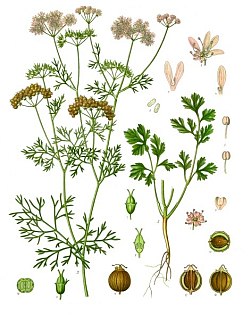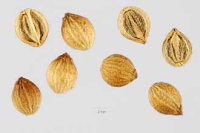Coriander Characteristics
(coriandrum sativum, linn.)

Name Origin:
The coriander plant is actually named from the ancient Greek Koris, a bug. The unattractive name can be attributed to the disagreeable odor of the foliage and other green parts. The scientific name actually translates into “cultivated buggy-smelling plant.” More on the History of Coriander.
Origins:
Thought to be a native of southern Europe and China.
Natural Order:
Umbelliferæ
Growing Cycle:
hardy annual herb
Height:
grows to 24 to 30 inches tall
Appearance:
Clusters of slightly divided leaves with a parsley-like appearance.
Flowers:
Umbels of small whitish flowers that are followed by pairs of brownish-yellow, deeply furrowed “seeds”
Fun Fact.
Ancient reasoning attributed anything with such a pronounced and unpleasant odor to possess powerful curative or preventative attributes. Coriander seeds have been found in Egyptian tombs dating to the 21st dynasty.
How to Grow Cilantro/Coriander
(Sowing seeds and harvesting cilantro or coriander seeds)
Growing Coriander From Seeds
Coriander seeds remain viable for 5-6 years and do not have the odd smell of the plant but have a rather agreeable smell and a moderately warm, pungent taste.
Coriander/cilantro grows best in light, warm, friable soil.

Coriander seeds are often sown in autumn but may also be sown in the spring. When growing coriander from seeds, sow the coriander seeds in rows about 15 inches apart spaced 1 inch asunder and one-half inch deep. Thin seedlings to 6 to 8 inches apart.
If you are primarily growing coriander to harvest cilantro leaves, place the plant in a cooler area of your garden to help prevent bolting.
Before growing coriander in your garden, check out our Coriander Companion Planting Guide to learn what other herbs can be planted with coriander.
Harvesting Cilantro.
Once the coriander plant is fairly established, you can cut off outer leaves for cilantro. Do not cut the center of the plant for optimum plant health.
Cut leaves should be stored like flowers with their stems in water or frozen until use.
Harvesting Coriander Seeds.
Once the flowers have finished and the seed heads or fruit begin to form, you can either cut and bundle the stems and store them in paper bags to dry or cover the flower heads on the plants securely with a paper bag and harvest at the end of the growing season.
Generally, the yield of coriander seeds is fairly small. More than enough for next year’s crop but perhaps not enough to harvest the spice. Many herb gardeners grow coriander primarily for cilantro leaves and only leave a plant or two to produce seeds.
Coriander & Cilantro Uses
(leaves and seeds)
Leaves.
The leaves of the coriander plant were once thought to be unsuitable for eating due to their strong odor and odd flavor. One early author wrote the following about coriander:
Some writers say the young leaves of the plant are used in salads and for seasoning soups, dressings, etc. If this is so, I can only remark that there is no accounting for tastes. I am inclined to think, however, that these writers are drawing upon their imagination or have been “stuffed” by people who take pleasure in supplying misinformation. The odor is such as to suggest the flavor of “buggy” raspberries we sometimes gather in the fence rows. Any person who relishes buggy berries may perhaps enjoy coriander salad or soup.
Guess that author never tasted salsa.
Many in the Americas prize coriander and use it’s leaves extensively in salsas and chutneys and refer to it as cilantro. Other parts of the word use coriander/cilantro leaves in curries, chutneys and rice dishes.
Seeds.
Coriander seeds are frequently used in the making of comfits and other kinds of confectionery, as a flavoring in breads, and as an ingredient in curry powder and other condiments. The seeds, have a pleasing aromatic smell which improves with time.
It was used in medicines to disguise the unpleasant flavors of some drugs. The seeds are also used for flavoring several types of liquors.